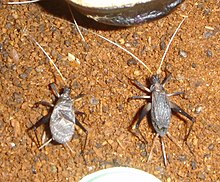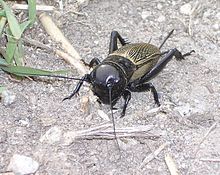Crickets as pets
[note 1] Throughout the Imperial era the Chinese also kept pet cicadas and grasshoppers, but crickets were the favorites in the Forbidden City and with the commoners alike.
The art of selecting and breeding the finest fighting crickets was perfected during the Qing dynasty and remained a monopoly of the imperial court until the beginning of the 19th century.
Modern Western sources recommend keeping pet crickets in transparent jars or small terrariums providing at least two inches of soil for burrowing and containing egg-crate shells or similar objects for shelter.
The speed of growth, coupled with the ease of breeding and raising nymphs, makes industrial-grown crickets a preferred and inexpensive food source for pet birds, reptiles, and spiders.
[7] Crickets are much smaller than the sound wavelengths that they emit, which makes them inefficient transducers, but they overcome this disadvantage by using external natural resonators.
Ground-dwelling field crickets use their funnel-shaped burrow entrances as acoustic horns; Oecanthus burmeisteri [sv] attach themselves to leaves which serve as soundboards and increase sound volume by 15 to 47 times.
[8] Chinese handlers increase the apparent loudness of their captive crickets by waxing the insects' tympanum with a mixture of cypress or lacebark pine tree sap and cinnabar.
[9] Entomologists from Ivan Regen onward have agreed that the principal purpose of a male cricket's "song" is to attract females for mating.
[10] Berthold Laufer and Frank Lutz recognized the fact but noted that it was not clear why males do it continuously throughout most of their adult lives, when actual mating doesn't take much time.
[18] The ancestors of modern Chinese people possessed a unique attitude towards small creatures, which is preserved in present-day culture of flower, bird, fish, insect.
[20] The Affairs of the period Tsin-Tao (742–756) mention that "whenever the autumnal season arrives, the ladies of the palace catch crickets in small golden cages ... and during the night hearken to the voices of the insects.
By this time, as evidenced in the painting, the Chinese had already developed the art of making clay cricket homes, the skills of careful handling of the insects, and the practice of tickling to stimulate them.
His cricket miraculously defeated all Emperor's insects; the ending reveals that the champion was mysteriously guided by the spirit of his own unconscious child.
[30] The ancient secrets of cricket handling and cricket-related crafts, only some of which were recorded on paper, were largely lost during the Chinese Civil War.
Earlier, most crickets sold in major cities were caught in the nearby countryside, but in the 21st century a local catch, or dichong, is extremely rare.
Trappers from the South use iron cage-like lanterns or fire baskets to carry smoldering charcoal which forces insects to flee from the smoke.
The captured crickets are then placed into a clay pot and stay there until being sold; they are fed a few boiled rice grains per day.
[41] In his 1927 book, Laufer described seven species of crickets kept by the people of Beijing; Oecanthus rufescens and Homeogryllys japonicus were the favorites based on their "singing" rather than fighting qualities.
[50] Crickets are placed in individual clay homes sprinkled with herbal medicines, bathed in licorice infusion every three to five days and fed according to each owner's secret recipes.
[51] The traditional diet of captive crickets, described by Laufer, consisted of seasonal green vegetables in the summer and masticated chestnuts and yellow beans in winter.
[54] The fights are held outdoors[55] in an oval ring (douzha),[54] which was traditionally a flat clay pot but is more commonly a plastic container today.
[60] According to an anonymous source of China Daily, secretive and elusive "luxury games" take place not in Shanghai but in the outlying provinces.
[6] Ceramic jars or pots with flat lids, introduced in the Ming period, are the preferred type of container for keeping the cricket in summer.
Inside, the jar may contain a cricket "bed" or "sleeping box" (lingfan) made of clay, wood, or ivory, and miniature porcelain "dishes".
The carved lids can be made of jade, coconut shell, sandalwood and ivory; the most common motif employs an ornament of gourd vines, flowers, and fruits.
[65] The ancient art of growing molded gourds was lost during the Cultural Revolution, when the old pastime was deemed inappropriate for Red China.
American film producers routinely insert clips of cricket sounds to tell the audience that the action takes place in summer.
[79] Chuzo was flooded with orders and switched exclusively to wholesale operations, supplying crickets to street dealers and collecting royalties from cage makers.
[80] During the Bunsei period the government contained competition between cricket dealers by limiting them to thirty-six, in a guild known as Ōyama-Ko (after Mount Ōyama) or, alternatively, the Yedo Insect Company.
Each year, three pairs of subadult crickets were caught in the wild and bred in a controlled lab environment to preserve the gene pool of the mother colony.









